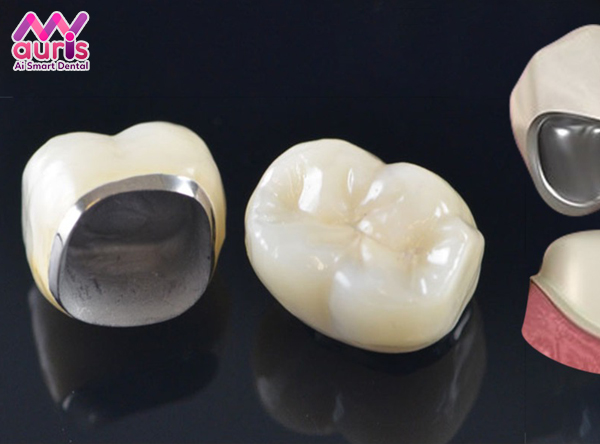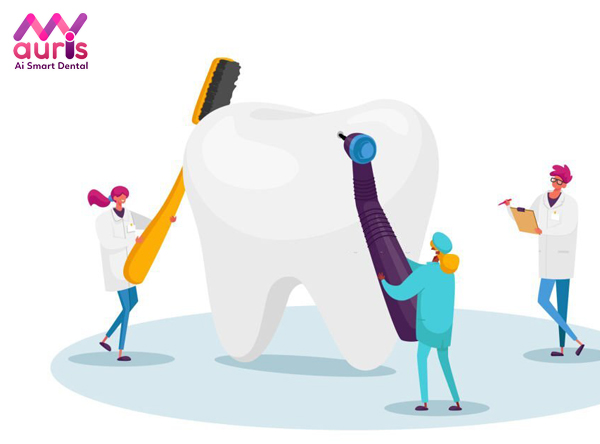Metal ceramic dental bridges are used in the dental bridge technique. This type of porcelain teeth helps you save money and ensures many aesthetic advantages. Why do many people choose this treatment method? Let’s find out with My Auris Dentistry!
What is the metal-ceramic dental bridge method like?
Ceramic dental bridge is a method of restoring lost teeth by grinding 2 real teeth on either side of the lost tooth position. To ensure the porcelain tooth bridging process, the real tooth must be healthy before placing a porcelain crown on top. The two ceramic crowns on the side are responsible for covering the two ground teeth while the porcelain tooth in the middle is used to replace the lost tooth.
Metal ceramic teeth are composed of 2 basic parts:
- The internal frame is made from alloys. The metal rib layer is about 0.3mm thick, made from alloys such as Nickel, Chromium, Titanium, and other high-end types such as gold, silver, diamonds, etc.
- The outside is covered with white ceramic layer fired at high temperatures to ensure aesthetics and longer-lasting quality.
However, the porcelain bridge space between the two crowns is designed to fit the missing tooth space. However, if you lose teeth for a long time, it leads to bone loss. The first thing you should do is bone grafting and then proceed with making a porcelain bridge.

Advantages and disadvantages of porcelain bridges
Restore the position of the missing teeth so that the teeth do not deviate towards the lost teeth. And brings aesthetics to your teeth and improves your chewing function.
- Advantages
- Helps you get durable new teeth because the porcelain bridge material is made of metal and has high restoration ability.
- Optimizes the chewing ability of teeth. Using porcelain bridges is very convenient, without many difficulties or looseness like removable dentures.
- The metal rib helps the porcelain bridge to be more durable and have more optimal strength. Limit cracking as well as external impact forces.
- High aesthetics due to the porcelain teeth being coated with high-quality porcelain, giving a bright white appearance and natural shine like real teeth.
- Longevity of porcelain bridge teeth is high, average porcelain bridge life expectancy Metal can be used for 7 – 10 years. If you take better care of your teeth.
- Avoid shifting of teeth and reduce pressure on gums and tooth tissue.
- Disadvantages
Ceramic dental bridges still cannot resolve bone loss due to not treating the tooth roots, therefore, after a while, you will have tooth bone loss that causes gum recession, sunken cheeks, and affects the aesthetics. Besides, porcelain bridges will invade these two real teeth over time will gradually weaken due to the impact on the tooth structure.
Ceramic dental bridge technique requires a highly skilled doctor. If the porcelain tooth is not carefully covered, it can easily leave gaps, easily causing dental diseases such as bad breath, gingivitis, etc.
The color is natural but not as diverse and colorful as all-ceramic porcelain teeth. In particular, after a period of using metal-ceramic teeth, black streaks may appear on the gum line, which will affect the aesthetics.

Procedure for making metal-ceramic bridges at the dentist
Ceramic dental bridges made of metal or any other method to be highly effective need to be performed according to standard dental procedures:
Step 1: Check your oral health
Checking your oral health helps the doctor check whether your oral health is qualified to make a porcelain bridge. If not, the doctor will treat dental diseases such as tooth decay, periodontitis, etc. and completely cure them before making a porcelain bridge.
In addition, the doctor will examine and check the current oral condition of the lost tooth position.
Step 2: Grind teeth
If the two real teeth next to the lost tooth position meet the criteria for healthy teeth, the doctor will definitely choose these two teeth and grind them down to stabilize the toothbattery for dental bridges.
Tooth grinding is done carefully and in detail by the doctor without affecting the real tooth structure as well as limiting the feeling of pain.
Step 3: Making porcelain crowns
After grinding your teeth, you will take tooth impressions and send them to the Labo room to make porcelain crowns. However, you can choose the type of metal-ceramic tooth that suits your needs.
Step 4: Install porcelain crowns
About 2-3 days later, the porcelain dental bridge will be successfully crafted. However, you need to go to the dentist so the doctor can clean your teeth and install the porcelain bridge. Porcelain bridges are fixed with specialized dental glue.
Although metal ceramic bridges still have many shortcomings, they are not the most optimal method of restoring missing teeth. These methods are very popular and reasonably priced for many people with different dental conditions.

How to take care of your teeth after making a porcelain bridge
To prolong the life of the porcelain bridge, ensuring chewing function and aesthetics perfect, you need to take good care of it. Here are some oral care tips:
- Use a soft-bristled toothbrush to clean both the area above and below the bridge at least twice a day.
- You can use a water flosser with antibacterial solution to keep the porcelain bridge area clean.
- Don’t forget to floss to clean your teeth.
- Regularly examine the dentist every 6 months so that the doctor can check your teeth as well as promptly detect and treat problems that may arise.
- Avoid chewing on ice or other hard objects to ensure the bridge is not damaged.
Hopefully this article about metal-ceramic dental bridges will be useful information about methods of restoring lost teeth. If you are having problems with your oral health, please contact us via Hotline 0896 164 568 or text via Fanpage for support and advice on your dental condition.your mouth.
You may be interested in:
? Is it possible to have porcelain crowns on front teeth? How much does it cost?
? How long does it take to get cosmetic porcelain crowns?
? How much does a full porcelain crown cost? Should I get a full porcelain crown?





